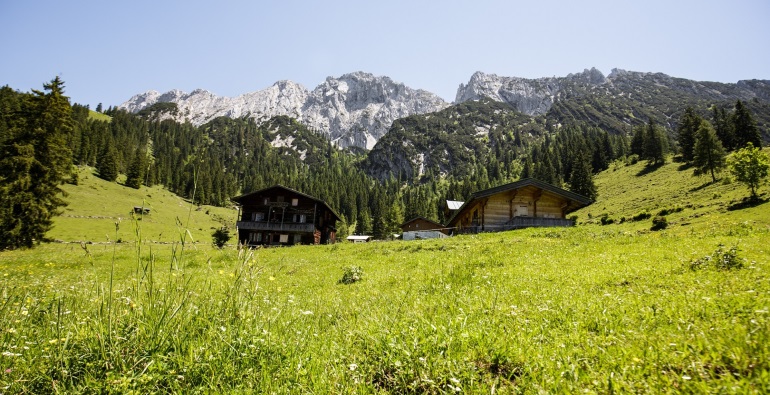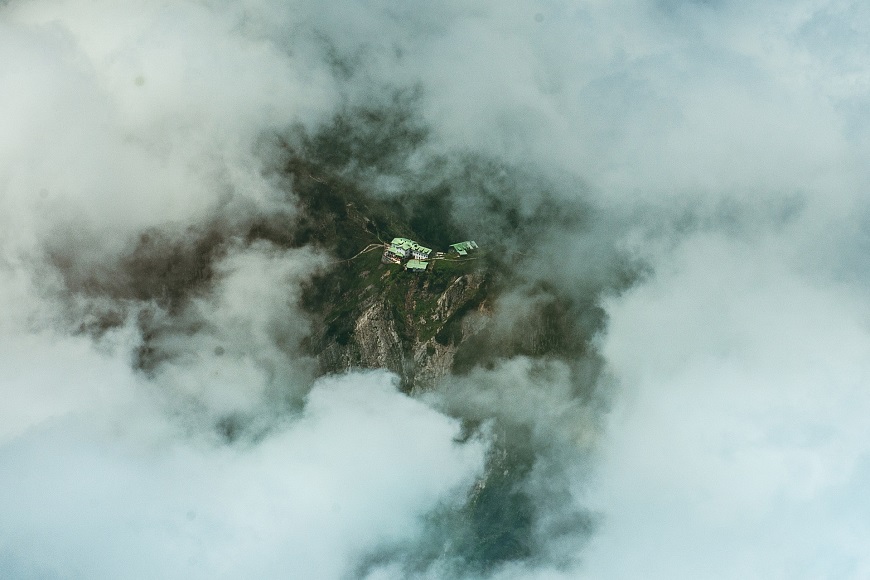Clocks tick differently on the alm

People & tales
Clocks tick differently on the alm
To answer our questions, we met the conservation area experts Nicole Schreyer – also member of the Greens’ Federal Council - and Philipp Larch. They talked about successfully completed projects in the past and planned ones for 2017.
The most exciting and complex environmental project in the current year was to restore the alpine pastures of the Stripsenalm. Anyone who things of cranes and concrete mixers is wrong.
Since an avalanche decades ago, the alp was neither cultivated, nor did anyone care about its pastures. Since the terrain is extremely steep and very difficult to access, you can’t blame anyone. But in 2017 the conservation area management started to maintain these rough pastures. They were assisted by the Kufstein section of the Austrian Alpine Association and a group of volunteers, consisting of ten nature-loving adventurers between 16-30 years. The project was scheduled to start at the end of July 2017. The entire group was booked in at the Stripsenjoch alpine hut and trained by the forester.
At first, the area had to be cleared of pines and other shrubs and trees, otherwise the pastures would have completely overgrown. This process is called "Schwenden". Once this was done, the next “troublemaker” had to be gotten rid of: the "Blaiken". Don’t worry we also didn’t know what "Blaiken" were. These are cracks in the ground, causing the soil to erode. The main task of the project was to repair the cracks.

The humus layer in the Kaiser Mountains is thin. Even very thin. Accordingly, the plants have difficulties growing on eroded soil without “leaving scars". Therefore, the ground had been covered with mats of coconut fiber and seeds were sowed. The goal was actually to use seeds from the Hinterkaiserhof farm located in the Kaisertal, leaving everything in the family, so to speak. Whether this would be possible, was not sure yet. In any case, the used seeds would have to be tested by experts to avoid neophytes. That leads us to the next project:
No, we do not mean a freshly baptized person, but vegetation: Neophytes are introduced, non-native plant species. And these neophytes threaten the rare flora and fauna in the Kaiser Mountains due to their rapid distribution. Already in 2015 and 2016 100 (!) volunteers helped to fight these neophytes. They include, for example, the Himalayan balsam, Japanese knotweed or the Canadian goldenrod. Well, plants do sometimes have weird names!
Since the operation had been very successful, controlling neophytes continued in 2017: along the Kaiseraufstieg (Kaiser ascent), the tunnel portal, and on the Griesner Alm in the Kaiserbachtal.
Of course, the experts not only take care of the diverse flora and fauna, but also the two-, four- and six-footed “inhabitants” of the conservation area.
Let's start with the crested newts and yellow-bellied toads: Both species are threatened and endangered. The monitoring area covers seven ponds of which two were created just for this purpose. The development of these creatures has been monitored for seven years and measures have been taken to improve their habitat.
The development of the yellow-bellied toads, for example, is monitored as follows:
Each toad has a unique pattern on its underside, its fingerprint, so to speak. The creatures are gently caught and placed in a transparent box. By doing so, you can see and test the pattern on the underside of the toad. If a toad with the same pattern is caught several times, the development of these creatures is bad. It increases if they have different patterns. This process is performed by an amphibian specialist.
Furthermore, the insect nesting aid in Hinterbärenbad has also been refilled and provides information. And since birdsongs make the idyll in the Kaisergebirge seem perfect, bird mapping is also on the agenda. It will be carried out with master students from the Innsbruck university. More specifically: owls, eagle owls and owls are mapped throughout the conservation area. With the collected data measures protecting the beautiful, but unfortunately seriously threatened, birds will be implemented.
In fact, nature reserves also suffer damages caused by the Web. Unfortunately, more and more users publish “back ways” on many internet platforms and interactive maps. Most of these users don’t realize that they destroy the habitat of wild animals. Because they notice immediately when their territory is entered and never come back again. The flora is also affected, because there is always someone finding its way through the vegetation by destroying plants.
Please do: Always stay on the signposted paths when hiking! You can thus contribute to the protection of our diverse, beautiful nature.
Finally, there is also a positive aspect: You won’t find much garbage in the Kaisertal left by its visitors. That's great, isn’t it?
#savetheplanet
That’s it!

0 Comment (s)
More comments